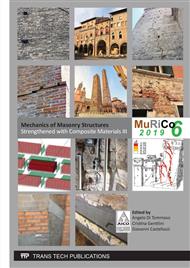p.44
p.50
p.57
p.65
p.73
p.83
p.89
p.95
p.105
Numerical Simulation of Geogrid Reinforced Adobe Walls
Abstract:
The paper describes the finite element model simulation of reinforced adobe walls to assess the feasibility of an innovative strengthening technique for earthen constructions, which improves the seismic performance. The retrofitting technique is based on the application of geogrids on both sides of the earthen wall. The geogrid is comprised in the mud plaster layer, which is applied to the wall surface in two steps. No additional connections are put in place, and the connection between the geogrid and the wall is granted exclusively by the mud plaster. The numerical simulation accounted for the presence of adobe blocks and clay joints, as well as for the presence of the reinforcing geogrid and of the mud plaster. The nonlinear behavior of the material was modeled with smeared cracking in tension and plasticity in compression, allowing to minimize the number of fitting material parameters. The numerical results are compared with the output from experimental tests [1] performed on almost twenty small walls without reinforcement, or with different types of geogrids available from the market. The laboratory tests included simple compression, diagonal shear, and three-point bending. The tests and the numerical simulation revealed that the retrofitting system is particularly effective from the mechanical point of view thanks to the optimal ratio between the wall and the geogrid stiffness and strength. The reinforced samples showed increased strength and greatly increased ductility, which is very promising in particular with respect to the seismic load behavior. The material compatibility between the geogrid and the mud plaster and the earthen wall is also very good, mainly due to the fact that geogrids were developed primarily for soil stabilization applications. The analyzed retrofitting system looks very promising for both the seismic improvement of existing vernacular heritage and for application in new bio-architecture building contexts.
Info:
Periodical:
Pages:
73-79
Citation:
Online since:
August 2019
Authors:
Keywords:
Price:
Сopyright:
© 2019 Trans Tech Publications Ltd. All Rights Reserved
Share:
Citation:


